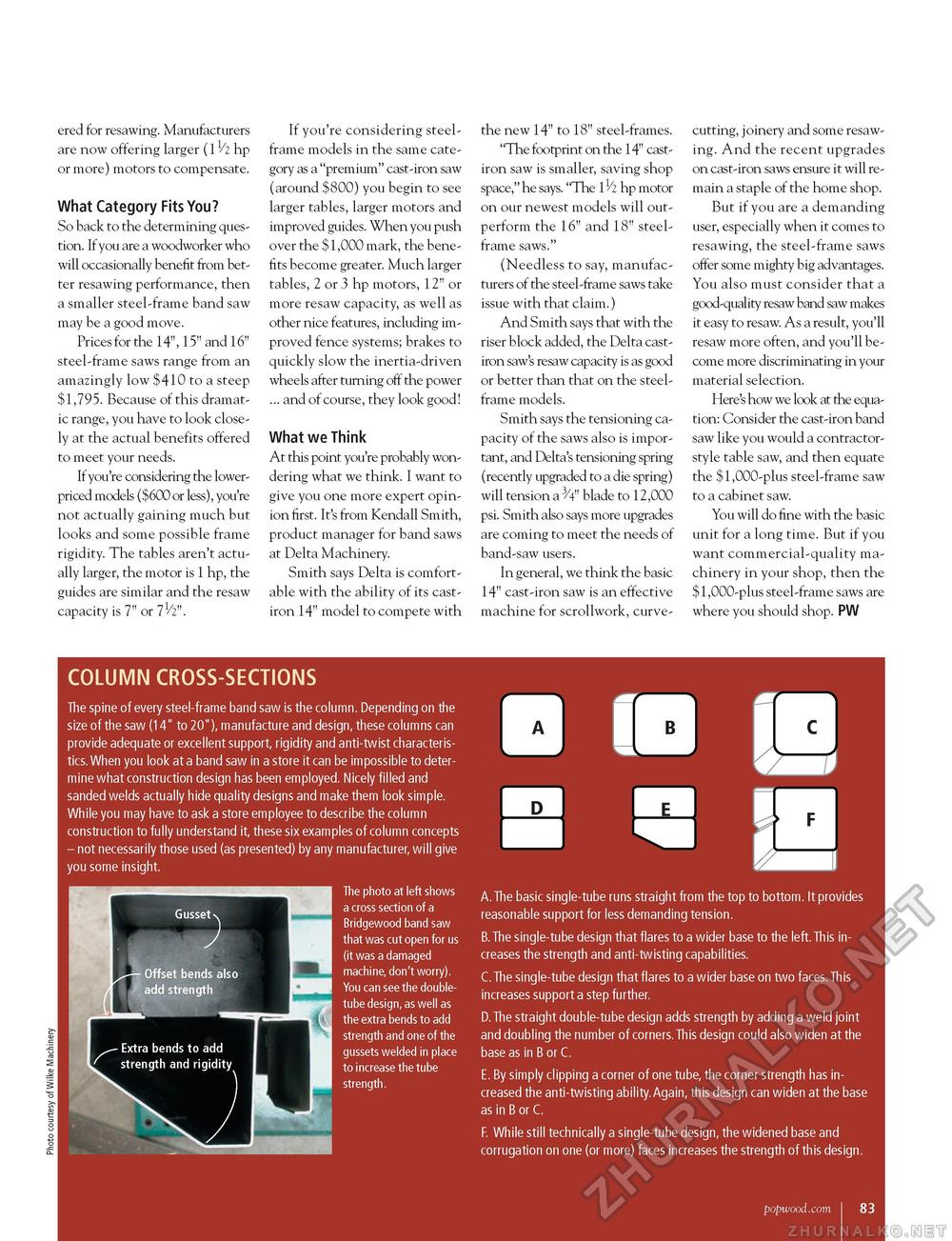Popular Woodworking 2003-06 № 134, страница 85
ered for resawing. Manufacturers are now offering larger (11/2 hp or more) motors to compensate. What Category Fits You? So back to the determining question. If you are a woodworker who will occasionally benefit from better resawing performance, then a smaller steel-frame band saw may be a good move. Prices for the 14", 15" and 16" steel-frame saws range from an amazingly low $410 to a steep $1,795. Because of this dramatic range, you have to look closely at the actual benefits offered to meet your needs. If you're considering the lower-priced models ($600 or less), you're not actually gaining much but looks and some possible frame rigidity. The tables aren't actually larger, the motor is 1 hp, the guides are similar and the resaw capacity is 7" or If you're considering steel-frame models in the same category as a "premium" cast-iron saw (around $800) you begin to see larger tables, larger motors and improved guides. When you push over the $1,000 mark, the benefits become greater. Much larger tables, 2 or 3 hp motors, 12" or more resaw capacity, as well as other nice features, including improved fence systems; brakes to quickly slow the inertia-driven wheels after turning off the power ... and of course, they look good! What we Think At this point you're probably wondering what we think. I want to give you one more expert opinion first. It's from Kendall Smith, product manager for band saws at Delta Machinery. Smith says Delta is comfortable with the ability of its cast-iron 14" model to compete with the new 14" to 18" steel-frames. "The footprint on the 14" cast-iron saw is smaller, saving shop space," he says. "The hp motor on our newest models will outperform the 16" and 18" steel-frame saws." (Needless to say, manufacturers of the steel-frame saws take issue with that claim.) And Smith says that with the riser block added, the Delta cast-iron saw's resaw capacity is as good or better than that on the steel-frame models. Smith says the tensioning capacity of the saws also is important, and Delta's tensioning spring (recently upgraded to a die spring) will tension a 3/4" blade to 12,000 psi. Smith also says more upgrades are coming to meet the needs of band-saw users. In general, we think the basic 14" cast-iron saw is an effective machine for scrollwork, curve- cutting, joinery and some resaw-ing. And the recent upgrades on cast-iron saws ensure it will remain a staple of the home shop. But if you are a demanding user, especially when it comes to resawing, the steel-frame saws offer some mighty big advantages. You also must consider that a good-quality resaw band saw makes it easy to resaw. As a result, you'll resaw more often, and you'll become more discriminating in your material selection. Here's how we look at the equation: Consider the cast-iron band saw like you would a contractor-style table saw, and then equate the $1,000-plus steel-frame saw to a cabinet saw. You will do fine with the basic unit for a long time. But if you want commercial-quality machinery in your shop, then the $1,000-plus steel-frame saws are where you should shop. PW COLUMN CROSS-SECTIONS The spine of every steel-frame band saw is the column. Depending on the size of the saw (14" to 20"), manufacture and design, these columns can provide adequate or excellent support, rigidity and anti-twist characteris-tics.When you look at a band saw in a store it can be impossible to determine what construction design has been employed. Nicely filled and sanded welds actually hide quality designs and make them look simple. While you may have to ask a store employee to describe the column construction to fully understand it, these six examples of column concepts - not necessarily those used (as presented) by any manufacturer, will give you some insight. -.----The photo at left shows Gusset a cross section of a ) I Bridgewood band saw y l&clSE that was cut open for us tdaiHB (it was a damaged /-"■Offset bends also machine, don't worry). ' y add strength You can see the double- I It^ y tube design, as well as the extra bends to add strength and one of the Extra bends to add gussets welded in place strength and rigidity to increase the tube ^v I r! F® strength. Extra bends to add strength and rigidity A.The basic single-tube runs straight from the top to bottom. It provides reasonable support for less demanding tension. B.The single-tube design that flares to a wider base to the left.This increases the strength and anti-twisting capabilities. C. The single-tube design that flares to a wider base on two faces. This increases support a step further. D. The straight double-tube design adds strength by adding a weld joint and doubling the number of corners.This design could also widen at the base as in B or C. E. By simply clipping a corner of one tube, the corner strength has increased the anti-twisting ability. Again, this design can widen at the base as in B or C. F. While still technically a single-tube design, the widened base and corrugation on one (or more) faces increases the strength of this design. popwood.com I 83 |








